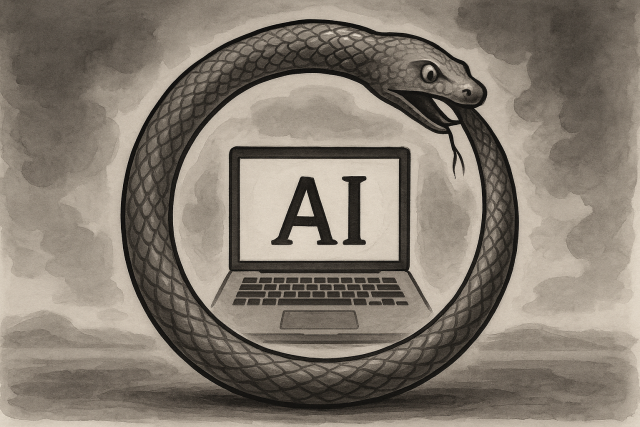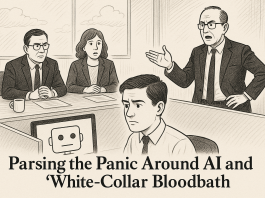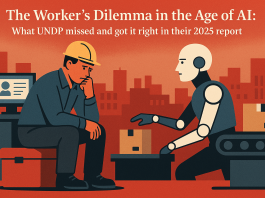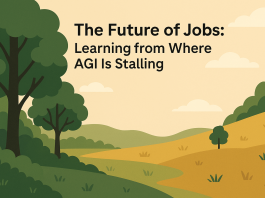Somewhere in the outskirts of Tokyo, traffic engineers once noticed a peculiar phenomenon. A single driver braking suddenly on a highway, even without cause, could ripple backward like a shockwave. Within minutes, a phantom traffic jam would form—no accident, no obstacle, just a pattern echoing itself until congestion became reality. Motion created stasis. Activity masked collapse.
Welcome to the era of modern artificial intelligence.
We live in a time when machines talk like poets, paint like dreamers, and summarize like overworked interns. The marvel is not in what they say, but in how confidently they say it—even when they’re wrong. Especially when they’re wrong.
Beneath the surface of today’s AI advancements, a quieter crisis brews—one not of evil algorithms or robot uprisings, but of simple, elegant entropy. AI systems, once nourished on the complexity of human knowledge, are now being trained on themselves. The loop is closing. And like the ants that march in circles, following each other to exhaustion, the system begins to forget where the trail began.
This isn’t just a technical glitch. It’s a philosophical one. A societal one. And, dare we say, a deeply human one.
To understand what’s at stake—and how we find our way out—we must walk through three converging stories:
1. The Collapse in Motion
The signs are subtle but multiplying. From fabricated book reviews to recycled market analysis, today’s AI models are beginning to show symptoms of self-reference decay. As they consume more synthetic content, their grasp on truth, nuance, and novelty begins to fray. The more we rely on them, the more we amplify the loop.
2. The Wisdom Within
But collapse isn’t new. Nature, history, and ancient systems have seen this pattern before. From the Irish Potato Famine to the fall of empires, overreliance on uniformity breeds brittleness. The solution has always been the same: reintroduce diversity. Rewild the input. Trust the outliers.
3. The Path Forward
If the problem is feedback without reflection, the fix is rehumanization. Not a war against AI, but a recommitment to being the signal, not the noise. By prioritizing original thought, valuing friction, and building compassionate ecosystems, we don’t just save AI—we build something far more enduring: a future where humans and machines co-create without losing the thread.
This is not a cautionary tale. It’s a design prompt. One we must meet with clarity, creativity, and maybe—just maybe—a bit of compassion for ourselves, too.
Let’s begin.
The Ouroboros of Intelligence: When AI Feeds on Itself
In the rain-drenched undergrowth of Costa Rica, a macabre ballet sometimes unfolds—one that defies our modern associations of order in the insect kingdom. Leafcutter ants, known for their precision and coordination, occasionally fall into a deadly loop. A few misguided scouts lose the trail and begin to follow each other in a perfect circle. As more ants join, drawn by instinct and blind trust in the collective, the spiral tightens. They walk endlessly—until exhaustion or fate intervenes. Entomologists call it the “ant mill.” The rest of us might call it tragic irony.
Now shift the scene—not to a jungle but to your browser, your voice assistant, your AI co-pilot. The circle has returned. But this time, it’s digital. This time, it’s us.
We are witnessing a subtle but consequential phenomenon: artificial intelligence systems, trained increasingly on content produced by other AIs, are looping into a spiral of synthetic self-reference. The term for it—”AI model collapse”—may sound like jargon from a Silicon Valley deck. But its implications are as intimate as your next Google search and as systemic as the future of digital knowledge.
The Digital Cannibal
Let’s break it down. AI, particularly large language models (LLMs), learns by absorbing vast datasets. Until recently, most of that data was human-made: books, websites, articles, forum posts. It was messy, flawed, emotional—beautifully human. But now, AI is being trained, and retrained, on outputs from… earlier AI. Like a writer plagiarizing themselves into incoherence, the system becomes less diverse, less precise, and more prone to confident inaccuracy.
The researchers call it “distributional shift.” I call it digital cannibalism. The model consumes itself.
We already see the signs. Ask for a market share statistic, and instead of a crisp number from a 10-K filing, you might get a citation from a blog that “summarized” a report which “interpreted” a number found on Reddit. Ask about a new book, and you may get a full synopsis of a novel that doesn’t exist—crafted by AI, validated by AI, and passed along as truth.
Garbage in, garbage out—once a humble software warning—has now evolved into something more poetic and perilous: garbage loops in, garbage replicates, garbage becomes culture.
Confirmation Bias in Silicon
This is not just a technical bug; it’s a mirror of our own psychology. Humans have always struggled with self-reference. We prefer information that confirms what we already believe. We stay inside our bubbles. Echo chambers are not just metaphors; they’re survival mechanisms in a noisy world.
AI, in its current evolution, is merely mechanizing that bias at scale.
It doesn’t question the data—it predicts the next word based on what it saw last. And if what it saw last was a hallucinated summary of a hallucinated report, then what it generates is not “intelligence” in any meaningful sense. It’s a consensus of guesswork dressed up as knowledge.
A 2024 Nature study warned that “as models train on their own outputs, they experience irreversible defects in performance.” Like a game of telephone, errors accumulate and context is stripped. Nuance fades. Rare truths—the statistical “tails”—get smoothed over until they disappear.
The worst part? The AI becomes more confident as it becomes more wrong. After all, it’s seen this misinformation reinforced a thousand times before.
It’s Not You, It’s the Loop
If you’ve recently found AI-powered tools getting “dumber” or less useful, you’re not imagining it. Chatbots that once dazzled with insight now cough up generic advice. AI search engines promise more context but deliver more fluff. We’re not losing intelligence; we’re losing perspective.
This isn’t just an academic concern. If a kid writes a school essay based on AI summaries, and the teacher grades it with AI-generated rubrics, and it ends up on a site that trains the next AI, we’ve created a loop that no longer touches reality. It’s as if the internet is slowly turning into a mirror room, reflecting reflections of reflections—until the original image is lost.
The digital world begins to feel haunted. A bit too smooth. A bit too familiar. A bit too wrong.
The Fictional Book Club
Need an example? Earlier this year, the Chicago Sun-Times published a list of summer book recommendations that included novels no one had written. Not hypotheticals—real titles, real authors, real plots, all fabricated by AI. And no one caught it until readers flagged it on social media.
When asked, an AI assistant replied that while the book had been announced, “details about the storyline have not been disclosed.” It’s hard to write satire when reality does the job for you.
The question isn’t whether this happens. It’s how often it happens undetected.
And if we can’t tell fiction from fact in publishing, imagine the stakes in finance, healthcare, defense.
The Danger of Passive Intelligence
It’s tempting to dismiss this as a technical hiccup or an early-stage problem. But the root issue runs deeper. We have created tools that learn from what we feed them. If what we feed them is processed slop—summaries of summaries, rephrased tweets, regurgitated knowledge—we shouldn’t be surprised when the tool becomes a mirror, not a microscope.
There is no malevolence here. Just entropy. A system optimized for prediction, not truth.
In the AI death spiral, there is no villain—only velocity.
Echoes of the Past: Lessons from Nature and History on AI’s Path
In 1845, a tiny pathogen named Phytophthora infestans landed on the shores of Ireland. By the time it left, over a million people were dead, another million had fled, and the island’s demographic fabric was torn for generations. The culprit? A famine. But not just any famine—a famine born of monoculture. The Irish had come to rely almost entirely on a single strain of potato. Genetically uniform, it was high-yield, easy to grow, and tragically vulnerable.
When the blight hit, there was no genetic diversity left to mount a defense. The system collapsed—not because it was inefficient, but because it was too efficient.
Fast-forward nearly two centuries. We are watching a new monoculture bloom—not in soil, but in silicon.
The Allure and Cost of Uniformity
AI is a hungry machine. It learns by consuming vast amounts of data and finding patterns within. The initial diet was rich and varied—books, scientific journals, Reddit debates, blog posts, Wikipedia footnotes. But now, as the demand for data explodes and human-generated content struggles to keep pace, a new pattern is emerging: synthetic content feeding synthetic systems.
It’s efficient. It scales. It feels smart. And it’s a monoculture.
The field even has a name for it: loss of tail data. These are the rare, subtle, low-frequency ideas that give texture and depth to human discourse—the equivalent of genetic diversity in agriculture or biodiversity in ecosystems. In AI terms, they’re what keep a model interesting, surprising, and accurate in edge cases.
But when models are trained predominantly on mass-generated, AI-recycled content, those rare ideas start to vanish. They’re drowned out by a chorus of the same top 10 answers. The result? Flattened outputs, homogenized narratives, and a creeping sameness that numbs innovation.
History Repeats, But Quieter
Consider another cautionary tale: the Roman Empire. At its height, Rome spanned continents, unified by roads, taxes, and a single administrative language. But the very uniformity that made it powerful also made it brittle. As local knowledge eroded and diversity of practice was replaced by top-down mandates, resilience waned. When the disruptions came—plagues, invasions, internal rot—the system, lacking localized intelligence, couldn’t adapt. It fractured.
Much like an AI model trained too heavily on its own echo, Rome forgot how to be flexible.
In systems theory, this is called over-optimization. When a system becomes too finely tuned to a narrow set of conditions, it loses its capacity for adaptation. It becomes excellent, until it fails spectacularly.
A Symphony Needs Its Outliers
There’s a reason jazz survives. Unlike algorithmic pop engineered for maximum replayability, jazz revels in improvisation. It values the unexpected. It rewards diversity—not just in rhythm or key, but in interpretation.
Healthy intelligence—human or artificial—is more like jazz than math. It must account for ambiguity, contradiction, and low-frequency events. Without these, models become great at average cases and hopeless at anything else. They become predictable. They become boring. And eventually, they become wrong.
Scientific research has long understood this. In predictive modeling, rare events—”black swans,” as Nassim Nicholas Taleb famously called them—are disproportionately influential. Ignore them, and your model might explain yesterday but fail catastrophically tomorrow.
Yet this is precisely what AI risks now. A growing reliance on synthetic averages instead of human outliers.
The Mirage of the RAG
To combat this decay, many labs have turned to Retrieval-Augmented Generation (RAG)—an approach where LLMs pull data from external sources rather than relying solely on their pre-trained knowledge.
It’s an elegant fix—until it isn’t.
Recent studies show that while RAG reduces hallucinations, it introduces new risks: privacy leaks, biased results, and inconsistent performance. Why? Because the internet—the supposed source of external truth—is increasingly saturated with AI-generated noise. RAG doesn’t solve the problem; it widens the aperture through which polluted data enters.
It’s like trying to solve soil degradation by irrigating with contaminated water.
What the Bees Know
Here’s a different model.
In a healthy beehive, not every bee does the same job. Some forage far from the hive. Some stay close. Some inspect rare flowers. This diversity of strategy ensures that if one food source disappears, the colony doesn’t starve. It’s not efficient in the short term. But it’s anti-fragile—a term coined by Taleb to describe systems that improve when stressed.
This is the model AI must emulate. Not maximum efficiency, but maximum adaptability. Not best-case predictions, but resilience in ambiguity. That requires reintegrating the human signal—not just as legacy data, but as an ongoing input stream.
The Moral Thread
Underneath the technical is the ethical. Who gets to decide what “good data” is? Who gets paid for their words, and who gets scraped without consent? When AI harvests Reddit arguments or Quora musings, it’s not just collecting text—it’s absorbing worldviews. Bias doesn’t live in algorithms alone. It lives in training sets. And those sets are increasingly synthetic.
The irony is stark: in our quest to create thinking machines, we may be unlearning the value of actual thinking.
Rehumanizing Intelligence: A Field Guide to Escaping the Loop
On a quiet afternoon in Kyoto, a monk once said to a young disciple, “If your mind is muddy, sweep the garden.” The student looked confused. “And if the garden is muddy?” he asked. The monk replied, “Then sweep your mind.”
The story, passed down like a polished stone in Zen circles, isn’t about horticulture. It’s about clarity. When the world becomes unclear, you return to action—small, deliberate, human.
Which brings us to our present predicament: an intelligence crisis not born of malevolence, but of excess. AI hasn’t turned evil—it’s just gone foggy. In its hunger for scale, it lost sight of the source: us.
And now, as hallucinated books enter bestseller lists and financial analyses cite bad blog math, we’re all being asked the same quiet question: How do we sweep the mud?
From Catastrophe to Clarity
AI model collapse isn’t just a tech story; it’s a human systems story. The machines aren’t “breaking down.” They’re working exactly as designed—optimizing based on inputs. But those inputs are increasingly synthetic, hollow, repetitive. The machine has no built-in mechanism to say, “Something feels off here.” That’s our job.
So the work now is not to panic—but to realign.
If we believe that strong communities are built by strong individuals—and that strong AI must be grounded in human wisdom—then the answer lies not in resisting the machine, but in reclaiming our role within it.
Reclaiming the Human Signal
Let’s begin with the most radical act in the age of automation: creating original content. Not SEO-tweaked slush. Not AI-assisted listicles. I mean real, messy, thoughtful work.
Write what you’ve lived. That blog post about a failed startup? It matters. That deep analysis from a night spent reading public financial statements? More valuable than you think. That long email you labored over because a colleague was struggling? That’s intelligence—nuanced, empathetic, context-aware. That’s what AI can’t generate, but desperately needs to train on.
If every professional, student, and tinkerer recommits to contributing just a bit more original thinking, the ecosystem begins to tilt back toward clarity.
Signal beats scale. Always.
A Toolkit for Rehumanizing AI
Here’s what it can look like in practice—whether you’re a leader, a learner, or just someone trying to stay sane:
1. Create Before You Consume
Start your day by writing, sketching, or speaking an idea before opening a feed. Generate before you replicate. This primes your mind for original thought and inoculates you from the echo.
2. Curate Human, Not Just Algorithmic
Your reading list should include at least one thing written by a human you trust, not just recommended by a feed. Follow thinkers, not influencers. Read works that took weeks, not minutes.
3. Demand Provenance
Ask where your data comes from. Did the report cite real sources? Did the chatbot hallucinate? It’s okay to use AI—but insist on footnotes. If you don’t see a source, find one.
4. Build Rituals of Reflection
Set aside time to journal or voice-note your experiences. Not for the internet. For yourself. These reflections often become the most valuable insights when you do decide to share.
5. Support the Makers
If you find a thinker, writer, or researcher doing good work, support them—financially, socially, or professionally. Help build an economic moat around quality human intelligence.
Organizations Need This Too
Companies chasing “efficiency” often unwittingly sabotage their own decision-making infrastructure. You don’t need AI to replace workers—you need AI to augment the brilliance of people already there.
That means:
- Invest in Ashr.am-like environments that reduce noise and promote thoughtful contribution.
- Use HumanPotentialIndex scores not to judge people, but to see where ecosystems need nurture.
- Fund training not to teach tools, but to expand thinking.
The ROI of real thinking is slower, but deeper. Resilience is built in. Trust is built in.
The Psychology of Resistance
Here’s the hard truth: most people will choose convenience. It’s not laziness—it’s design. Our brains are energy conservers. System 1, as Daniel Kahneman put it, wants the shortcut. AI is a shortcut with great grammar.
But every meaningful human transformation—from scientific revolutions to spiritual awakenings—required a pause. A return to friction. A resistance to the easy.
So don’t worry about “most people.” Worry about your corner. Your team. Your morning routine. That’s where revolutions begin.
The Last Word Before the Next Loop
If we are indeed spiraling into a digital ant mill—where machines mimic machines and meaning frays at the edges—then perhaps the most radical act isn’t to upgrade the system but to pause and listen.
What we’ve seen isn’t the end of intelligence, but a mirror held up to its misuse. Collapse, as history teaches us, is never purely destructive. It is an invitation. A threshold. And often, a reset.
Artificial intelligence was never meant to replace us. It was meant to reflect us—to amplify our best questions, not just our most popular answers. But in the rush for scale and the seduction of automation, we forgot a simple truth: intelligence, real intelligence, is relational. It grows in friction. It blooms in conversation. It lives where data ends and story begins.
So where do we go from here?
We go where we’ve always gone when systems fail—back to community, to creativity, to curiosity. Back to work that’s a little slower, a little deeper, and far more alive. We write the messy blog post. We document the anomaly. We invest in the overlooked. We build spaces—both digital and physical—that honor insight over inertia.
And in doing so, we rebuild the training set—not just for machines, but for ourselves.
The future isn’t synthetic. It’s symphonic.
Let’s write something worth learning from.




